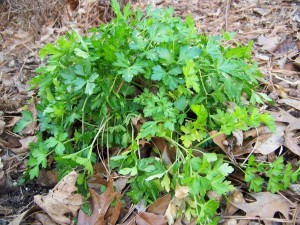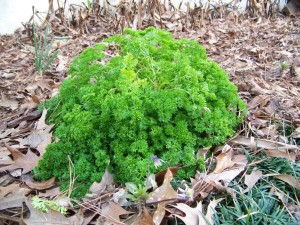 While
most of us think of Parsley as a throw-away garnish we find on our restaurant
entrees, in reality this is an extremely useful herb that's packed with
nutrients, including vitamin A, more vitamin C then an orange, several B
vitamins, iron, calcium, and more.
While
most of us think of Parsley as a throw-away garnish we find on our restaurant
entrees, in reality this is an extremely useful herb that's packed with
nutrients, including vitamin A, more vitamin C then an orange, several B
vitamins, iron, calcium, and more.
Parsley has an easy, gentle flavor and works well in blending other flavors
together in a given dish. There are three main types, curly leaf,
flat leaf, and parsnip-rooted. Parsley is a
biennial herb,
and can be used in most foods except sweets. It is used widely in
different cuisines around the world, including French and Middle Eastern
dishes. The flat leaf variety has the most flavor, the curly leaf
variety is the prettiest, and the parsnip variety is used like a parsnip,
though we don't see it used very often in America.
 Parsley
can be started from seed or bought already started at any garden store in
the spring. Seed starting is a slow process - it can take up to six
weeks to get the seed to germinate, so buying starts is usually the best
method. Six plants should supply a family with enough for fresh use,
freezing, and drying. Parsley prefers a rich soil, but will survive
in almost any soil type. It likes full sun, but will also tolerate
part shade. It does well in containers, but be sure to plant it where
it is going to grow permanently, as it resents transplanting. Harvest
the outer stalks regularly, and cut off any flower stalks to keep it productive.
Also keep weeds in check, as they compete with the Parsley and weaken the
plant. In warmer climates, Parsley sets seed in its second year, and
this seed can be harvested for a new crop the next spring. If you
do decide to start this plant from seed, plant in the spring when all danger
of frost has passed, or start inside 6 weeks before the last frost.
Parsley
can be started from seed or bought already started at any garden store in
the spring. Seed starting is a slow process - it can take up to six
weeks to get the seed to germinate, so buying starts is usually the best
method. Six plants should supply a family with enough for fresh use,
freezing, and drying. Parsley prefers a rich soil, but will survive
in almost any soil type. It likes full sun, but will also tolerate
part shade. It does well in containers, but be sure to plant it where
it is going to grow permanently, as it resents transplanting. Harvest
the outer stalks regularly, and cut off any flower stalks to keep it productive.
Also keep weeds in check, as they compete with the Parsley and weaken the
plant. In warmer climates, Parsley sets seed in its second year, and
this seed can be harvested for a new crop the next spring. If you
do decide to start this plant from seed, plant in the spring when all danger
of frost has passed, or start inside 6 weeks before the last frost.
Parsley has merit in the ornamental garden
and the curly leaf type especially makes a nice addition to cool weather
plantings. Try combining with colorful pansies or snapdragons, or
use by itself as an attractive walkway border. Parsley also makes a good
companion plant in the garden (please see
Companion Planting
for more information).
 While
most of us think of Parsley as a throw-away garnish we find on our restaurant
entrees, in reality this is an extremely useful herb that's packed with
nutrients, including vitamin A, more vitamin C then an orange, several B
vitamins, iron, calcium, and more.
While
most of us think of Parsley as a throw-away garnish we find on our restaurant
entrees, in reality this is an extremely useful herb that's packed with
nutrients, including vitamin A, more vitamin C then an orange, several B
vitamins, iron, calcium, and more.  Parsley
can be started from seed or bought already started at any garden store in
the spring. Seed starting is a slow process - it can take up to six
weeks to get the seed to germinate, so buying starts is usually the best
method. Six plants should supply a family with enough for fresh use,
freezing, and drying. Parsley prefers a rich soil, but will survive
in almost any soil type. It likes full sun, but will also tolerate
part shade. It does well in containers, but be sure to plant it where
it is going to grow permanently, as it resents transplanting. Harvest
the outer stalks regularly, and cut off any flower stalks to keep it productive.
Also keep weeds in check, as they compete with the Parsley and weaken the
plant. In warmer climates, Parsley sets seed in its second year, and
this seed can be harvested for a new crop the next spring. If you
do decide to start this plant from seed, plant in the spring when all danger
of frost has passed, or start inside 6 weeks before the last frost.
Parsley
can be started from seed or bought already started at any garden store in
the spring. Seed starting is a slow process - it can take up to six
weeks to get the seed to germinate, so buying starts is usually the best
method. Six plants should supply a family with enough for fresh use,
freezing, and drying. Parsley prefers a rich soil, but will survive
in almost any soil type. It likes full sun, but will also tolerate
part shade. It does well in containers, but be sure to plant it where
it is going to grow permanently, as it resents transplanting. Harvest
the outer stalks regularly, and cut off any flower stalks to keep it productive.
Also keep weeds in check, as they compete with the Parsley and weaken the
plant. In warmer climates, Parsley sets seed in its second year, and
this seed can be harvested for a new crop the next spring. If you
do decide to start this plant from seed, plant in the spring when all danger
of frost has passed, or start inside 6 weeks before the last frost.